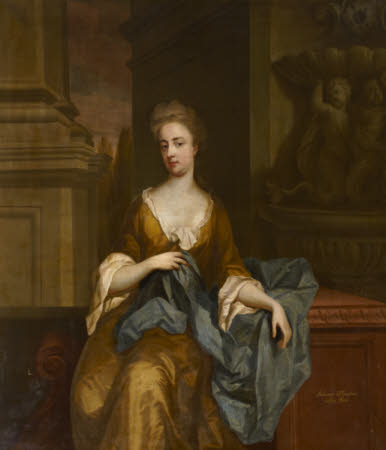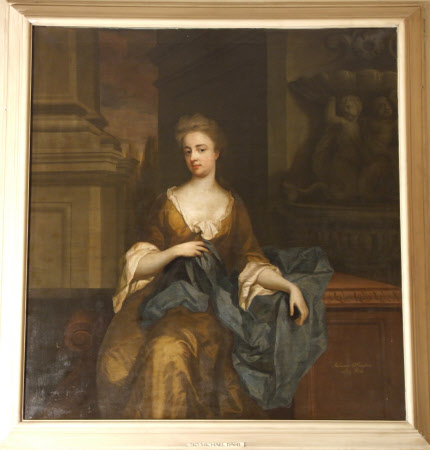Juliana Alington, Viscountess Howe (1665-1747)
Michael Dahl (Stockholm 1659 - London 1743)
Category
Art / Oil paintings
Date
c. 1695 - c. 1699
Materials
Oil on canvas
Measurements
1650 x 1550 mm
Place of origin
England
Order this imageCollection
Petworth House and Park, West Sussex
NT 486221
Caption
Juliana Alington, Viscountess Howe was the daughter of William, 3rd Baron Alington and Juliana Noel. She was baptised at Horseheath, a few miles from Cambridge. Juliana married the Whig politician Scrope Howe, 1st Viscount Howe (1648-1713) in 1698, who was appointed Comptroller of Excise by King William III in 1693. The couple had three daughters and a son. She was the cousin of Petworth’s owner Charles Seymour, 6th Duke of Somerset (1662-1748). The Petworth Beauties This picture is one of the Petworth Beauties, a series of eight female portraits which decorate the Beauty Room at Petworth House. Seven were painted, c.1695-99, by the Swedish artist Michael Dahl (1659-1743), and one by Sir Godfrey Kneller (1646-1723), dated 1705. Acquired by Charles Seymour, 6th Duke of Somerset (the ‘Proud Duke’, 1662-1748), and Lady Elizabeth Percy (1667-1722), for the Dining Room of their newly refurbished house, the Petworth Beauties were originally set into panelling, between mirrors, and surmounted by paintings of cupids by Symon Stone (active 1646-71) after Polidoro da Caravaggio. The engraver George Vertue (1684-1756), who visited Petworth House in the 1730s, described the portraits in his notebooks as ‘beauties. these are very well & deserve the characters of the best works of Mr. Dahl.’ On another occasion, he wrote: ‘At Petworth are several whole length pictures of Ladyes, beautyes, painted several years ago for the Duke of Somersett, that shew the great skill of Mr. Dahl in Art, beauty, of grace, genteel artfull draperies finely painted & well dispos’d.’ Six of the eight portraits (not the two overdoors) were originally full-length, but they were shortened by George Wyndham, 3rd Earl of Egremont (1751-1837) in the 1820s to make room for a series of paintings and sculpture relating to the Napoleonic wars. The 3rd Earl is quoted as saying: ‘I will cut off their legs, I do not want their petticoats; their heads shall be placed in three small panels above and the battles [Vittoria and Waterloo by George Jones] with the marble bust of the Duke [of Wellington] shall be placed below them.’ This involved cutting off the bottoms of the portraits, which sections, rather than being disposed of, were attached to the lining, and folded up behind the portraits. Two portraits (Lady Mary Somerset, Duchess of Ormonde [NT486210] and Rachel Russell, Duchess of Devonshire [NT486212]) were restored to full-length by the National Trust in 2019 with support from Philip Mould & Company for Tate Britain’s exhibition British Baroque: Power and Illusion (2020). The Petworth Beauties are comparable to the series of Beauties at Hampton Court Palace by Sir Godfrey Kneller, commissioned in 1690-1 by Queen Mary II (1662-94). Tabitha Barber has suggested that the Petworth Beauties may have sought to represent the ‘personal “court”’ of the Duke and Duchess of Somerset, in response to the Hampton Court Beauties, which represented the ladies of Queen Mary’s court. The political and court roles of the women and their husbands may have been a factor in their selection, as well as family bonds with the Somersets. The Petworth Beauties have occasionally been believed, mistakenly, to represent the ladies of the court of Queen Anne.
Summary
Oil painting on canvas, Juliana Alington, Viscountess Howe (1665-1747) by Michael Dahl (Stockholm 1656/9 – London 1743), 1690s. A three-quarter-length portrait, of a young woman, seated, full front, with her head turned three-quarters left. Her left hand is on a parapet, her right hand is at her breast, holding her blue mantle over a grey-gold dress. In the background is a fountain at right and a fluted column at left.
Full description
The Petworth Beauties This picture is one of the Petworth Beauties, a series of eight female portraits which decorate the Beauty Room at Petworth House. Seven were painted, c.1695-99, by the Swedish artist Michael Dahl (1659-1743), and one by Sir Godfrey Kneller (1646-1723), dated 1705. Acquired by Charles Seymour, 6th Duke of Somerset (the ‘Proud Duke’, 1662-1748), and Lady Elizabeth Percy (1667-1722), for the Dining Room of their newly refurbished house, the Petworth Beauties were originally set into panelling, between mirrors, and surmounted by paintings of cupids by Symon Stone (active 1646-71) after Polidoro da Caravaggio. The engraver George Vertue (1684-1756), who visited Petworth House in the 1730s, described the portraits in his notebooks as ‘beauties. these are very well & deserve the characters of the best works of Mr. Dahl.’ On another occasion, he wrote: ‘At Petworth are several whole length pictures of Ladyes, beautyes, painted several years ago for the Duke of Somersett, that shew the great skill of Mr. Dahl in Art, beauty, of grace, genteel artfull draperies finely painted & well dispos’d.’ Six of the eight portraits (not the two overdoors) were originally full-length, but they were shortened by George Wyndham, 3rd Earl of Egremont (1751-1837) in the 1820s to make room for a series of paintings and sculpture relating to the Napoleonic wars. The 3rd Earl is quoted as saying: ‘I will cut off their legs, I do not want their petticoats; their heads shall be placed in three small panels above and the battles [Vittoria and Waterloo by George Jones] with the marble bust of the Duke [of Wellington] shall be placed below them.’ This involved cutting off the bottoms of the portraits, which sections, rather than being disposed of, were attached to the lining, and folded up behind the portraits. Two portraits (Lady Mary Somerset, Duchess of Ormonde [NT486210] and Rachel Russell, Duchess of Devonshire [NT486212]) were restored to full-length by the National Trust in 2019 with support from Philip Mould & Company for Tate Britain’s exhibition British Baroque: Power and Illusion (2020). The Petworth Beauties are comparable to the series of Beauties at Hampton Court Palace by Sir Godfrey Kneller, commissioned in 1690-1 by Queen Mary II (1662-94). Tabitha Barber has suggested that the Petworth Beauties may have sought to represent the ‘personal “court”’ of the Duke and Duchess of Somerset, in response to the Hampton Court Beauties, which represented the ladies of Queen Mary’s court. The political and court roles of the women and their husbands may have been a factor in their selection, as well as family bonds with the Somersets. The Petworth Beauties have occasionally been believed, mistakenly, to represent the ladies of the court of Queen Anne.
Provenance
Painted for the 6th Duke of Somerset (1662-1748) in the late 1690s. Thence by descent, until the death in 1952 of the 3rd Lord Leconfield, who had given Petworth to the National Trust in 1947, and whose nephew and heir, John Wyndham, 6th Lord Leconfield and 1st Lord Egremont (1920-72) arranged for the acceptance of the major portion of the collections at Petworth in lieu of death duties (the first ever such arrangement) in 1956 by H.M.Treasury.
Credit line
Petworth House, The Egremont Collection (acquired in lieu of tax by HM Treasury in 1956 and subsequently transferred to the National Trust)
Marks and inscriptions
(inscribed with name)
Makers and roles
Michael Dahl (Stockholm 1659 - London 1743), artist
References
Walpole Society (Great Britain) twentieth volume of the Walpole Society, 1931-1932 : 1932., p. 81 Walpole Society (Great Britain) twenty-second volume of the Walpole Society, 1933-1934 : 1934., p. 43 Jones 1849: George Jones, Sir Francis Chantrey, RA: Recollections of his Life, Practice and Opinions, London 1849, pp. 121-22 Barber 2020: Tabitha Barber, "The Petworth Beauties", Art and the Country House https://doi.org/10.17658/ACH/PTE530, Accessed 30/03/2022 Oxford Dictionary of National Biography, Accessed 11/03/2022


